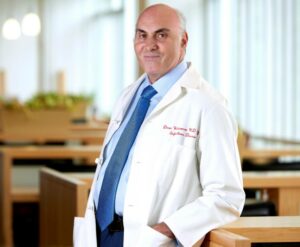
We might not have had a COVID-19 vaccine without the research of Dr. Drew Weissman, the Jewish University of Pennsylvania Roberts Family Professor in Vaccine Research.
Along with his colleague Katalin Kariko, an adjunct professor of neurosurgery at Penn, Weissman figured out how to make RNA vaccines a “viable tool” for wide distribution, according to a 2021 Jewish Exponent story.
In 2005, Weissman and Kariko figured out that “by changing one of the four bases, or letters, in RNA,” they could make it non-inflammatory. Before, it made mice sick. The duo’s discovery helped it take advantage of RNA’s potential for wide distribution. RNA does not need to replicate a specific virus to work as a vaccine.
When COVID-19 emerged, “they, along with Moderna and Pfizer, were able to quickly adapt an RNA vaccine to combat the virus.”
Their ability to do so won them the Nobel Prize in Medicine on Oct. 2.
“The laureates contributed to the unprecedented rate of vaccine development during one of the greatest threats to human health in modern times,” said The Nobel Assembly in a news release.
In an article about the award, The New York Times credited the COVID-19 vaccines with “averting tens of millions of deaths.”
But Weissman said he doesn’t think about the number.
“Saving lives matters,” he said. “The number is less important.”
Winning the prize was a triumph at the international level. But it only came at the end of a long journey that started with Weissman not even being able to get grant money for RNA research. He discussed that journey and what kept him going.
How hard was it to keep going with this work when you were doing it in the wilderness?
We kept getting interesting data. There were a lot of bad moments when studies weren’t funded, or papers weren’t published. But we saw the potential of RNA.
I was lucky I had other lines of research (such as HIV) that I could keep my lab funded. Otherwise, I would have disappeared. We finally got a grant for RNA in 2007. We had been working on it for about 10 years.
People had tried RNA. It had failed. Everybody gave up on it. We started by identifying the reasons why it failed, and that’s what we tackled for the first years.
Increasing the amount of protein made. Decreasing the amount of immunogenicity. When we got to our 2005 paper, we were sure that RNA would work.
The problem with RNA up until that point was you couldn’t inject it into an animal because the animal got sick from inflammation. Nucleoside modification got rid of the inflammation.
We also got more protein which made it more effective. When you take aspirin, you take a certain dose, so you have an effect. The more protein the body can make, the more effective the vaccine will be.
With that (first) grant, we showed that you could deliver erythropoietin to mice and non-human primates and see a potent effect. That’s when companies like Moderna and BioNTech became interested in using RNA.
We started to get more grants, and I started to work with a lot of vaccine experts around the country and world. Showing them the RNA vaccine. A lot of them became very interested and adopted the programs. Barney Graham at NIH (National Institutes of Health) and Bart Haynes at Duke (University) switched their programs to using RNA in their vaccines.
If you look at COVID-19, for the adenoviral vaccines, the antibody titers are similar or a little bit lower to what you see in infected people. But for RNA vaccines they’re 3-5 times higher. That tells you how potent the RNA vaccine is.
What was it like when RNA came to the mainstream light and you were lauded as a hero?
I’m a clinician researcher. My dream when I started this was to someday develop a new therapeutic that helped people. I think I can say I accomplished that.
What can RNA still accomplish?
There’s already been a phase one clinical trial using RNA to treat a genetic disorder that has shown fantastic success. It’s already being used for gene therapy.
And we’ve got a big program looking at sickle cells, gene therapy for immune deficiencies, bone marrow disorders, liver diseases. We’ve even got a program looking at neurodegenerative and neurological diseases.
We’ve been working on a pan-coronavirus vaccine since the spring of 2020. The hope is that it will protect against future variants and against any bad coronavirus that tried to cross over. There have been three coronavirus epidemics in the past 20 years. You have to know there’s going to be more.






